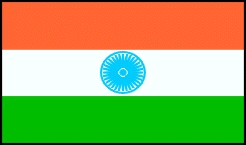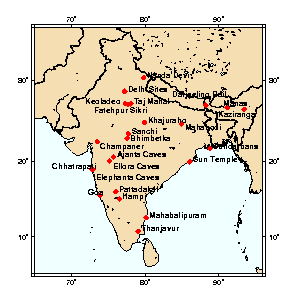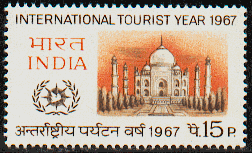


The Buddhist caves at Ajanta contain some of India's most magnificent paintings. The 29 caves were excavated beginning around 200 BC, but they were abandoned in 650 AD in favour of Ellora. Five of the caves were temples and 24 were monasteries, thought to have been occupied by some 200 monks and artisans. The Ajanta Caves were gradually forgotten until their `rediscovery' by a British tiger-hunting party in 1819.
The Buddhist, Hindu and Jain caves at Ellora, carved between 600 and 1000 AD, include 34 monasteries and temples dug side by side in the wall of a high basaltic cliff not far from Aurangabad. It seems that the caves were started by the Buddhist builders of Ajanta when they deserted that site, but later non-Buddhist caves were created simultaneously in a flowering of creative competition between the different religions.

The foundation was laid by emperor Akbar in 1565 AD, this huge fort is made of red-sandstone. It houses the Pearl mosque and many other noteworthy structures such as the Jahangir Palace or the Khas Mahal, built by Shah Jahan.
The Mogul emperor Shah Jahan had this immense funerary mosque of white marble built between 1631 and 1648 in memory of his favorite wife.

Built in the 13th century, this temple was dedicated to the Sun God and was originally designed in the form of his chariot.
The great Pallava rulers built these monuments in the period 630-800 AD.
Located in Assam, this is one of the last areas in northern India undisturbed by man. The largest population of one-horned rhinoceroses in the world inhabits Kaziranga Park.
Endangered species including the golden langur, hispid hare, and pygmy hog live in this wildlife sanctuary.

This park was once a duck hunting reserve of the Maharajas. Today it is one of the major wintering areas for large numbers of aquatic birds from Afghanistan, Turkmenistan, China, and Siberia. Some 364 species of birds, including the rare Siberian crane, have been recorded in the Park. It is also known as Bharatpur Bird Sanctuary.

The churches in Goa, of many different religious denominations illustrate the evangelization of Asia.
These Hindu temples were constructed between the 9th and 12th centuries.
Last capital of the last great Hindu kingdom of Vijayanagar.
The "City of Victory" was Akbar's capital for approximately 12 years. Akbar selected Sikri as the seat of his government believing it to be auspicious for himself. He experimented both with architecture and art and built a city expressing his ideals and vision. The finest monuments within this area are the Diwan-i-Am, Diwan-i-Khas, Panch House, Panch Mahal, Buland Darwaza and the tomb of Saint Shaikh Salim Chisti, and the Jama Masjid (one of the largest mosques in India).
On an island in the Oman Sea near Bombay are four rock-cut temples on Elephanta Island. Thought to have been carved out between 450 and 750 AD, they survived Portuguese vandalism and remain equal in size, beauty and power to the caves at Ajanta and Ellora. The main cave contains large sculpted panels relating to Siva, including his marriage to Parvati, the killing of Andhakasura, and the six-metre-high triple-headed Trimurti - in which Siva embodies the roles of creator, preserver and destroyer.
Built by emperor Raja Raja who ruled between 985 and 1012 AD.

The mouths of the Ganges form the world's largest delta, and part of this vast mangrove swamp, some 100 km south of Calcutta, is a 2585-sq-km wildlife reserve. Part of Project Tiger, Sundarbans has one of the largest tiger populations of any of India's parks.
Strong winds, daily drizzle, and regular heavy snowfall have created a unique climate and hence a distinctive flora and fauna in this largely inaccessible region. Notable fauna inclue the musk deer, leopard, Himalayan black bear and the snow partridge.

The first monuments were erected between 272 and 237 BC during the reign of Asaka. Construction continued up until the 12th century.


Humayun was the second Moghul emporer. His tomb was built in the mid-16th century by Haji Begum, wife of Humayun. It comprises a squat building with high arched entrances topped by a bulbous dome and surrounded by formal gardens. The gardens also contain the red-and-white sandstone and black-and-yellow marble tomb of Humayun's wife and the tomb of Humayun's barber.
Qutab Minar is a 73-meter-high victory tower, built in 1193 by Qutab-ud-din immediately after the defeat of Delhi's last Hindu kingdom. It symbolises Islamic rule of the city. The tower tapers from 15 meters in diameter at the base to 2.5 meters at the top. The stairs inside the tower coil very steeply and the inside of the tower has been closed to visitors since a stampede during a school trip in 1979 resulted in a number of deaths.
This site includes three railways: Darjeeling, Nilgiri, and Kalka Shimla. All three railways are currently still operational. The Darjeeling Himalayan Railway, opened in 1881, is an outstanding example of a hill passenger railway with ingenious engineering solutions to the problem of establishing an effective rail link across a mountainous terrain of great beauty. The Nilgiri Mountain Railway, a 46-km long metre-gauge single-track railway in Tamil Nadu State was first proposed in 1854, but due to the difficulty of the mountainous location the work only started in 1891 and was completed in 1908. This railway, scaling an elevation of 326 m to 2,203 m, represented the latest technology of the time. The Kalka Shimla Railway, a 96-km long, single track working rail link was built in the mid-19th century to provide a service to the highland town of Shimla.
Located in Madhya Pradesh, Bhimbetka is where the earliest known traces of human life in India were found. Stone age rock shelters and paintings date back 9,000 years.
Frederick Stevens designed the main train station in Bombay for the Great Indian Peninsular Railway. It opened in 1887 in time to celebrate Queen Victoria's Golden Jubilee. The style combines the Venetian Gothic popular in England at the time with elements of Indian architecture, and is built in the local red sandstone. A thirteen-foot personification of Progress, raising her arm toward the skies, tops the central dome.
The Red Fort was the palace for Shah Jahan's new capital, Shahjahanabad, the seventh Muslim city in the Delhi site when he moved his capital from Agra in the 17th century.
The Jantar Mantar observatory in Jaipur is one of the most significant ahnd best preserved collections of architectural astronomical instruments in India. It was built between 1727 and 1734 by Maharaja Jai Singh II.
Includes the following 6 Forts:
Stepwells are a form of subterranean water storage system that have evolved since the 3rd millennium BC. Rani-ki-Vav was designed as an inverted temple divided into seven levels of stairs with artistic sculptural panels. It was built as a memorial to a king in the 11 century AD.
The excavated remains of Nalanda Mahavihara comprise the ruins of a Buddhist monastic and educational center. The main stupa was built by Emperor Ashoka in the 3rd century BC and contains the relics of Sariputta, one of two chief male disciples of Gautama Buddha. The remains consist of an earlier cluster of stupa-centered buildings and a later linear system on a north-south axis.
Multiple sites in: Argentina, Belgium, France, Germany, India, Japan, and Switzerland (multiple sites)
Chosen from the work of Le Corbusier, the 17 sites comprising this transnational serial property are spread over seven countries and are a testimonial to the invention of a new architectural language that made a break with the past. They were built over a period of a half-century, in the course of what Le Corbusier described as "patient research".
This Himalayan site includes the 8586m high peak of Khangchendzonga, the 3rd highest in the world. The landscape features glaciers and glacial lakes, and is the habitat of species such as the snow leopard, red panda and Asian black bear.
The walled city dates from the 15th century and is known for a fusion of Hindu, Jain and Islamic elements.
The nominated area includes 94 historic buildings and the open green space of the Oval Maidan. They were created during the two major urban expansions of the city, adding Victorian Gothic public buildings in the late 19th century and Art Deco commercial/private ones in the 1930s.
Founded in 1727 by Sawai Jai Singh II. Unlike other cities in the region located in hilly terrain, Jaipur was established on the plain and built according to a grid plan interpreted in the light of Vedic architecture.
Ramappa Temple is the main Shiva temple in a walled complex built during the Kakatiyan period (1123-1323 CE).
This ancient city located on the arid island of Khadir in Gujarat was occupied betwee 3000-1500 BC. It is on of the best preserved urban settlements from this period.
Established in rural West Bengal in 1901 by the renowned poet and philosopher Rabindranath Tagore, Santiniketan was a residential school and center for art.
Three most representative examples of Hoysala-style temple complexes in southern India, dating from the 12th to 13th centuries: Channakeshava Temple, Hoysalesvara Temple, and Keshava Temple.
Burial System of the Ahom Dynasty in the foothills of the Patkai Ranges in eastern Assam.
The property includes twelve major fortifications. ( locations)
Last Updated: July 23, 2025